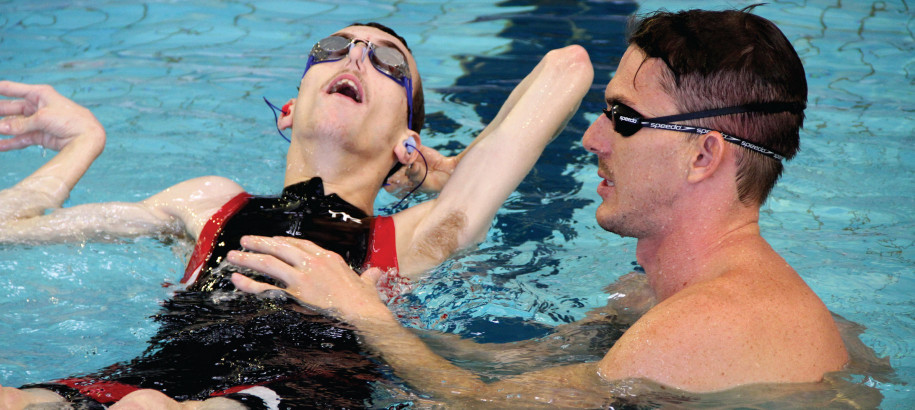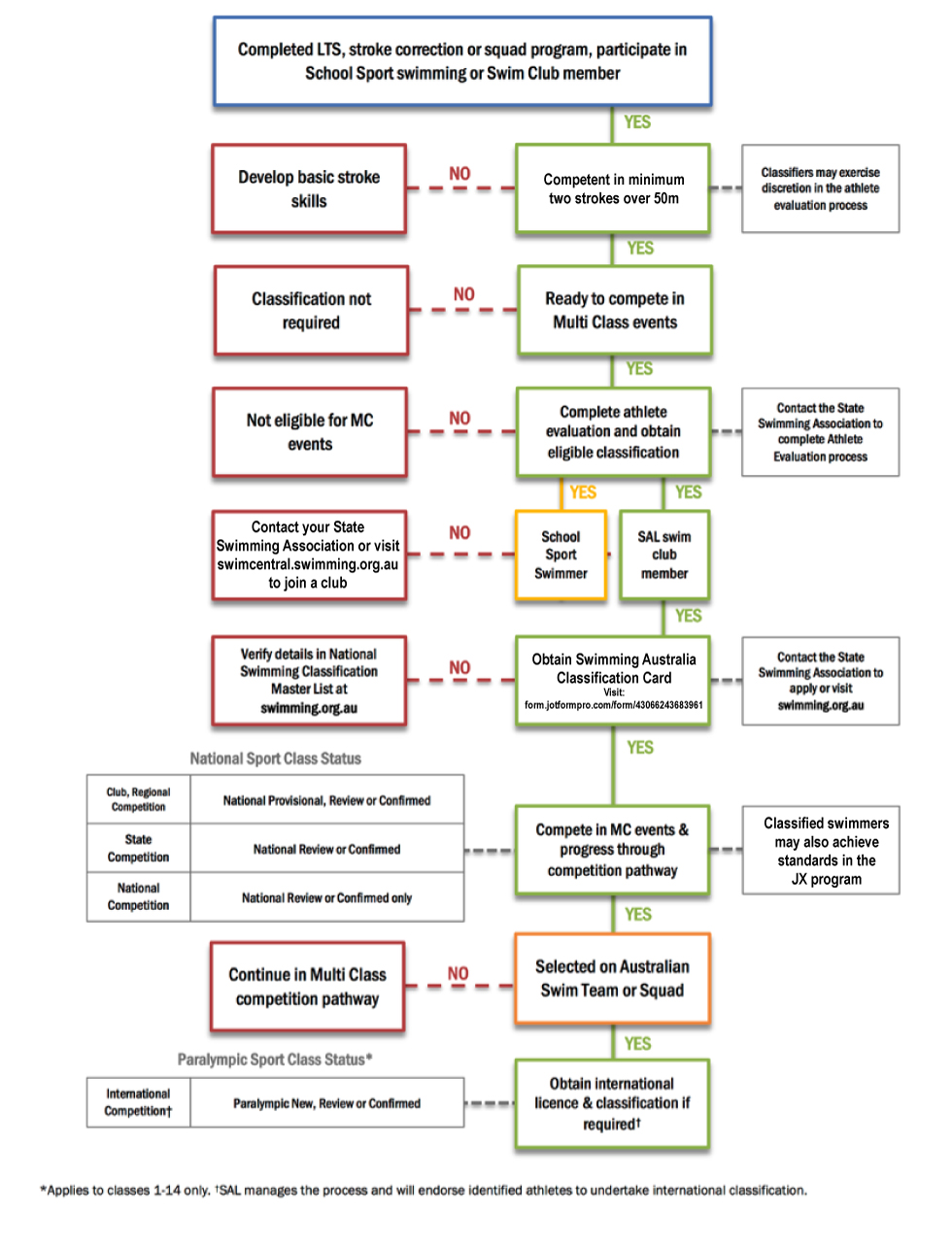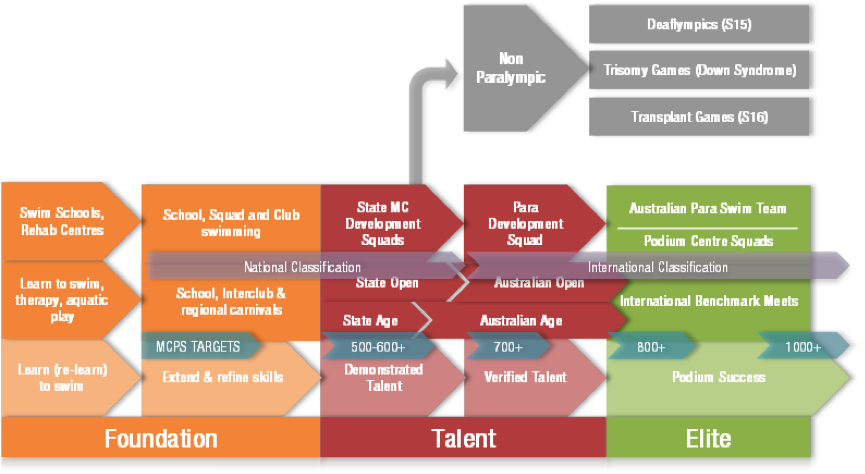
Multi Class swimming refers to the international structure of classifying a competitor according to their ability and therefore providing a fair and even structure for swimmers with disability.
At Swimming Queensland (SQ) we aim to provide an inclusive model across all skill levels and interactions with our sport, ensuring equal opportunity for swimmers with disability in our competition and development structures. Below you will find the relevant information if you’re looking to be classified and compete as a swimmer with disability and answer some of the most frequently asked questions, to help you in your swimming journey.
If you’re new to swimming and the classification system, you might like to check out the introduction to multi class swimming below.
Classification and the Multi Class System Explained
Getting Classified
The classification system groups athletes according to the impact of their impairment on their ability to compete in the sport of swimming. This helps ensure a fair competition environment for all swimmers, at all levels of competition.
- Understanding Classification
- How to Get Classified
- The Classification Pathway
The Classification System
There are 19 national classifications, 18 internationally recognised, that fit within the categories below:
Classifications 1-10: People with a physical impairment
Classifications 11-13: People with a visual impairment
Classification 14: People with an intellectual impairment
Classification 15: People with a hearing impairment
Classification 16: People with a transplant
Classification 17: Transition classification (not recognised internationally)
Classification 18: People with intellectual impairment & a significant other impairment (e.g. Down syndrome)
Classification 19: People with Autism
These classifications underpin multi class swimming and provide a fair system when swimmers with disability compete, which is explained in more detail below.
Classifications are required for each of the main competitive strokes and swimmers will receive a classification for each of these according to their abilities. These letters will appear before the classification number e.g. S3, SB2, SM3 or S14, SB14, SM14.
S: Freestyle, Backstroke, Butterfly
SB: Breaststroke
SM: Medley
Exceptions
Some swimmers may also receive exceptions to the swimming rules based on their classification, which prevent classified swimmers being disqualified during Multi Class competition. These exceptions will be determined during the classification process. You can find a list of the Swimming Codes of Exceptions in the Resources section below.
National Sport Class Status
Once a swimmer has completed the classification process and received a classification, they will also be issued with a National Sport Class Status. This gives an indication as to whether there are restrictions to the level of competition the swimmer may compete at and whether their classification requires review in a set period of time.
Swimming Australia has simplified the process of getting classified through the Multi Class Swimming Engagement Portal.
By completing a few short questions about yourself, the portal will help you determine if you might be eligible to be classified. From there you’ll be provided with the information you need to go and get classified.
Access the portal to begin the process of getting classified.
Once a swimmer is classified, their details are recorded in the National Swimming Classification Master List, which is published to assist swimmers and meet officials to identify current classifications.
Swimming Australia members who have completed the Athlete Evaluation process will receive a classification card (presented on their Swim Central membership card) that indicates their eligible classifications, exceptions and National Sport Class Status.
In order to be classified, swimmers will need to undergo an Athlete Evaluation Process. The image below provides an overview of Swimming Australia’s Classification Pathway.

You can find more information about this process in the Swimming Australia Classification Policies and Procedures Manual in the Resources section below.
Competition Opportunities for Swimmers with Disability
- What is Multi Class Competition?
- How Multi Class Results Are Calculated?
- Multi Class Records
- International Competition
- Classification Cards for Competition
- Classes (e.g. S8 SB7 SM8)
- Login to Swim Central
- On the menu list, select the ‘Profiles’ tile and select ‘View Profile’ (if you are a parent/guardian, select the relevant dependent)
- Select the active club membership. This will showcase the membership card and present the classification information.
Multi Class competition provides a fair approach for swimmers with disability by grouping them according to their classification.
Swimming Queensland encourages Multi Class competition to be integrated wherever possible at all levels of competition.
Once classified, a swimmer with disability is eligible to compete in Multi Class races according to their classification and National Sport Class Status, which determines the level of competition the swimmer may compete in (i.e. club, regional, state or national level meets).
Swimmers with disability may compete in an able-bodied event and have any relevant exceptions to the swimming rules applied, so long as the equivalent multi class event is not in the meet program. This is likely to be the case at smaller events such as club and regional meets.
Some competitions include multi class events that cater for swimmers with disability in which any relevant exceptions to the swimming rules are applied. Swimming Queensland incorporates multi class events into each of our Championship events, and where appropriate our preparation meets.
Find out more about what type of swim meets are available here or check out our events calendar for upcoming events.
Multi Class results are calculated according to a swimmer's classification. This means that the first person to touch the wall in a race will not necessarily be the official first-place getter.
The Multi Class Point Score Calculator (MCPS) determines the results and official placing for Multi Class events. This score is based off the World Record for their class as at 1 October, awarding points to the competitor according to how close they are to the World Record.
You can view your Multi Class Point Score for an individual result using the Online Multi Class Point Score Calculators in the Resources section below. Here you’ll also find the base times the current Multi Class Point Score is calculated from.
Swimmers with disability can also achieve Queensland, National or World Records* according to their classification.
For more details on current records and how to claim a multi class record, visit our Records page.
*Note, in order to achieve a World Record, a swimmer must have an International Paralympic Classification. See the International Competition section below for more details.
Multi Class competition at an international level is sanctioned by the International Paralympic Committee (IPC) and includes events such as the Paralympics.
To compete at IPC approved and sanctioned competitions, swimmers must obtain International Paralympic Classification. Generally, swimmers with disability who are selected on the Australian Dolphins Swim Team are invited to undergo International Paralympic Classification by the Swimming Australia Para High Performance Manager.
All swimmers with a current international Paralympic classification can be viewed on the IPC International Swimming Classification Master List, which is available in the Resources section below.
Swimming Australia Members
The Swimming Australia Classification Card is intended to assist the effective management of Multi-Class Competition. It provides an official record of an individual competitor’s classifications and any applicable rule exceptions. The Classification Card proves eligibility to compete in Multi-Class competition or other competition where classifications and rule exceptions are enforced. The card is issued to swimming club members who have an eligible swimming classification.
Over the past 10 years or so it has been common practice to present a classification card to the relevant Technical Official at swim meets to prove eligibility. Swimming Australia is now phasing these physical cards out and moving the information that is contained within the National MC Masterlist into Swim Central.
Your classification information will now show on your membership card in Swim Central as per the following example:
! Exceptions (e.g. *A 6,9)
i Review year (e.g. 2022)
Note: exceptions that contain a * signify that the member contains an exception that is applied from the IPC code of exceptions.
IPC Code Exceptions can be found here. (Nationally classified swimmers)
WPS Code Exceptions can be found here. (Internationally classified swimmers)
To locate this within Swim Central:
When required, you may be asked to present this information to meet organisers. To do so, you can pull this up on a device (whether screenshotted or by logging into Swim Central) or alternatively print off and have on hand.
Non-Swimming Australia Members
Meet organisers are also able to refer to the Swimming Australia Masterlist which shows eligibility of all classified participants: https://www.swimming.org.au/performance/elite/classification
Multi Class Athlete Development
- Swimming Queensland Development Activities
- Australian Junior Excellence Program
- Swimming Australia Talent ID & Development Pathway
Through our athlete development programs we provide opportunities for swimmers with disability to gain access to high-level expertise and develop their competitive skills.
Selection into Swimming Queensland’s McDonald’s Development Squads is based on times achieved throughout the season, using the Multi Class Point Score calculator.
Learn more about our development opportunities and selection criteria.
The Australian Junior Excellence Program was established in 2007 to recognise, reward and incentivise junior swimmers who are on a key part of their swimming journey, learning and refining as they develop into senior swimmers. Each year Swimming Australia releases the JX criteria and standards for the forthcoming season which swimmers, parents and coaches can use to as targets throughout the year.
Previously targeted towards swimmers aged between 9-16 years, the program has narrowed its focus and will now make the eligible age range 9-13 years.
Swimmers aged from 9 to 13 years, who accomplish times set by Swimming Australia, qualify at gold, silver, bronze or blue standard, depending on their best performance/s during the season.
All ‘approved’ swim meet results are loaded into the Swimming Australia’s Swim Central and used as results towards an overall award for each individual swimmer. At the end of the qualification period, Swimming Australia will publish the JX results on the website.
The qualification criteria for swimmers with disability are created using the Multi Class Point Score system. You can view the current selection criteria for JX on the Swimming Australia website.
Swimming Australia is dedicated to the long-term development of swimmers with disability and has created the below overview of the Paralympic Swimming Development Pathway.

For more information on Swimming Australia’s Talent ID and Development Pathway, visit their website.
FAQ’s & Resources
- Resources
Classification Resources
Swimming Australia Classification Policy
National Classification Master List – Available on the Swimming Australia Website
IPC International Swimming Classification Master List
View The Sport Inclusion Australia National Eligibility List (S14)
Swimming Codes of Exceptions - National | International
Multi Class Point Score Calculators and Base Times
Refer to the Swimming Australia website for the most up to date calculators and base times.
National Disability Sport Partners
Down Syndrome Swimming Australia

